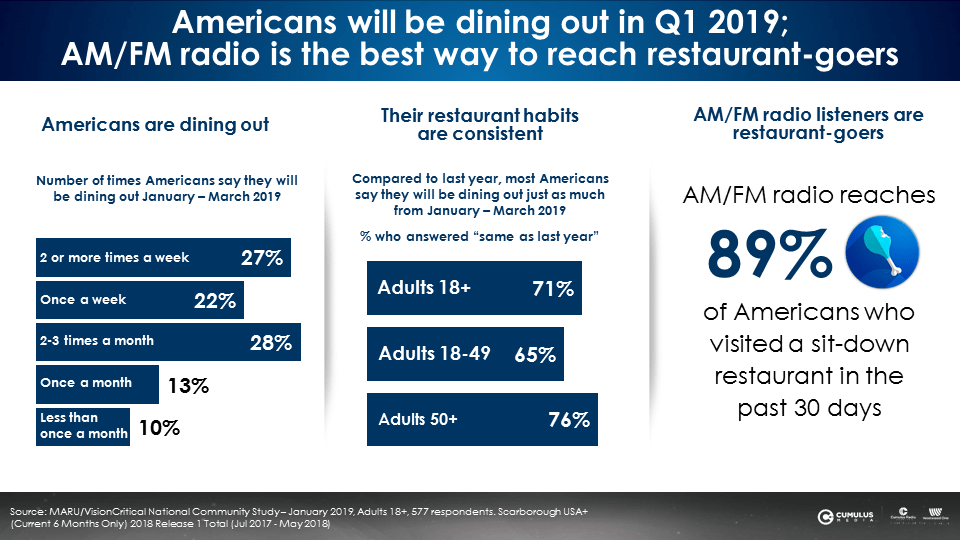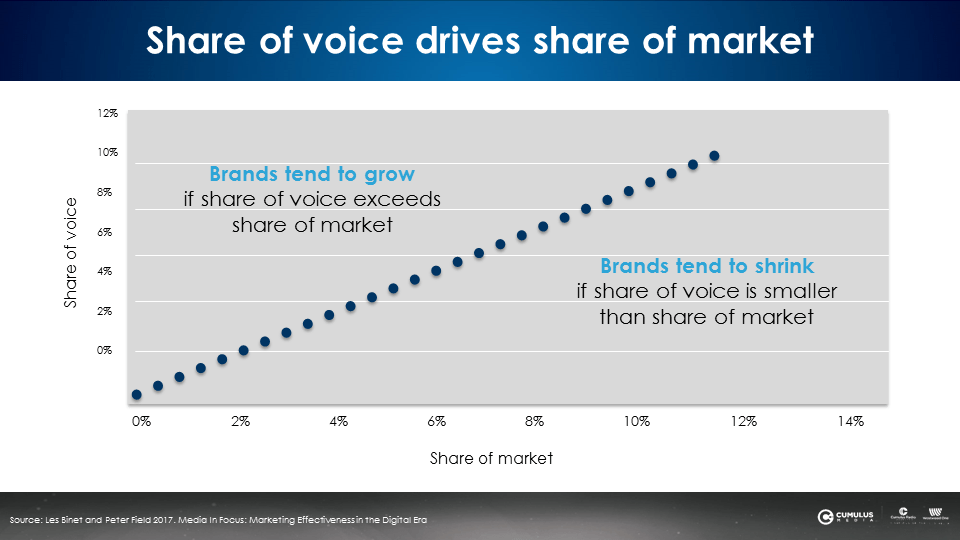Good News For Restaurants: Dining Out Still On The Menu For Americans This Winter
Due in part to colder weather, resolutions to save money, and the lingering effects of “Dry January,” an oft-heard question from restaurants at the start of every year is, “Why advertise now when no one is dining out?”
Do they have a point? Are Americans cutting back on their restaurant visits starting January straight through March? CUMULUS MEDIA | Westwood One commissioned a national study with MARU/VisionCritical to find out. We asked 577 Americans about their expected dining out behavior during these months. The results were illuminating.

Half of Americans will dine out at least once a week this winter
22% of Americans indicate they will dine out once a week. An additional 27% say they will dine out two or more times a week through March. Another 41% say they will dine out at least once a month.
Compared to the same months last year, Americans have consistent restaurant habits
71% of Americans say they will dine out just as much this year as they did in 2018. Interestingly, older 50+ Americans are even more likely to say their restaurant habits will be consistent.
To capture customers and grow their share, restaurants should advertise when their competitors do not
Other restaurants buying into the lower traffic narrative and not advertising is exactly the reason why restaurants who want to increase sales should be. Here’s why:

Share of voice: ad budgets as a percentage of category ad spend
To understand business growth trajectory, first determine “share of voice.”
Share of voice is ad spend divided by category ad spend. Say a restaurant spends $50,000 dollars a year on advertising in a town where there is $500,000 dollars of dining advertising.
Divide the store ad spend over category spend to determine share of voice. $50,000 divided by $500,000 equals a 10% share of voice. In essence, the restaurant represents 10% of dining advertising in the market.
Share of market: revenues as a percentage of category revenues
Market share is a brand or retailer’s revenue divided by category sales.
For example, a restaurant generates $1 million dollars in sales in a town where there is $10 million dollars of total dining sales. Divide the restaurant’s sales over total category sales to determine the market share.
$1 million divided by $10 million equals a 10% share of category spend. The store gets a ten share of dining sales in the market.
Here’s how to use this information to predict the sales outcome:
- If share of voice exceeds share of market, sales tend to grow.
- If share of voice is similar to share of market, sales tend to be stable.
- If share of voice is smaller than share of market, sales tend to shrink.
A restaurant’s sales momentum is based on the ad spend of competitors. If most of the market is not advertising in winter, then it’s easy for a restaurant to earn a strong share of voice and, in turn, grow sales!
AM/FM radio works for restaurants with massive reach and a desirable audience of on-the-go diners
For restaurants willing to take the advertising plunge during these months, AM/FM radio offers everything they need:
- Massive reach: AM/FM radio reaches 9 out of ten people who dine out every week. AM/FM radio can get the word out to drive a restaurant’s sales and grow business with new customers.
- Desirable audience: AM/FM radio also attracts working Americans. Nielsen reports that 76% of AM/FM radio listeners fall in the 18-64 age bracket and are in the workforce, making them a demographic with incomes to spend.
- On-the-go diners: Those in the workforce are also commuting to and from work. 68% of AM/FM radio listening occurs away from home, according to Nielsen. This on-the-go consumption by listeners means advertisers can use the medium to reach hungry consumers on the path to purchase.
Speak directly to consumer objections to dining out in winter to drive restaurant sales
There are dollars on the table for restaurants. Though seasonal fluctuations exist, plenty of Americans will be dining out this winter. A way to attract customers is to tailor AM/FM radio copy to the consumer mindset and strategically address reasons for not dining out.
- Promote pick up or delivery: Acknowledge the cold and utilize messaging to creatively tout the convenience of pick up, delivery, and dining at home.
- Create and promote programs that focus on winter weather conditions: Duke Moscrip of Duke’s restaurants in Seattle runs a Rain Check program. “His staff gives customers business card-sized ‘rain checks’ on sunny days to use when it’s raining for various discounts,” according to Food Newsfeed.
- Give restaurant-goers a reason to visit with special deals: Entice consumers by offering deals such as two-for one meals, a discount off, or free appetizers.
Advertising grows business. There’s no reason for restaurants not to promote themselves on-air. As Brian Papstein, General Manager of radio stations in Eureka, California, states, “A funny thing happens when you don’t advertise — nothing!”
In the face of industry hearsay, smart restaurants can use AM/FM radio to raise their share of voice in the market and drive sales. With the help of strategic creative messaging, Americans can be sold on solid reasons to keep dining out.
Key takeaways:
- Half of Americans will dine out at least once a week this winter
- Compared to the same months last year, Americans have consistent restaurant habits
- To capture customers and grow their share, restaurants should advertise when their competitors do not
- AM/FM radio works for restaurants with massive reach and a desirable audience of on-the-go diners
- Speak directly to consumer objections to dining out in winter to drive restaurant sales
Pierre Bouvard is Chief Insights Officer at CUMULUS MEDIA | Westwood One.
Contact the Insights team at CorpMarketing@westwoodone.com.